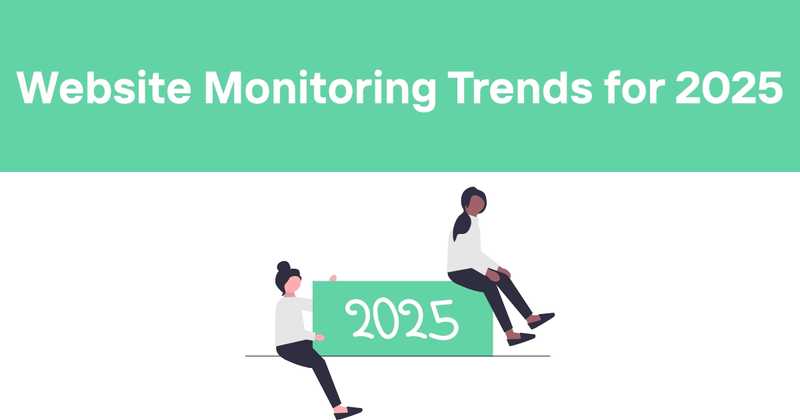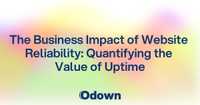Website Monitoring Trends for 2025
As we look ahead to 2025, the landscape of website monitoring continues to evolve rapidly. New technologies are emerging, while existing practices are being refined and optimized. For businesses and developers alike, staying on top of these trends is crucial for maintaining high-performing, reliable digital services.
I've been in the trenches of web development and operations for over a decade now, and I have to say - the pace of change never fails to amaze me. Just when you think you've got a handle on things, some new paradigm shift comes along and shakes everything up. But that's what keeps this field exciting, right?
So let's dive into the key website monitoring trends that I believe will shape the industry in 2025. I'll share my perspective on what's driving these changes and how they might impact your monitoring strategies. Buckle up - it's going to be an interesting ride!
Table of Contents
- The Rise of AI-Powered Monitoring
- Edge Computing and Distributed Monitoring
- Observability Takes Center Stage
- Security-First Monitoring
- User Experience as a Key Metric
- Sustainability in Monitoring Practices
- Integration of IT and OT Monitoring
- Cloud-Native Monitoring Solutions
- Predictive Analytics in Website Monitoring
- Automation and Self-Healing Systems
- The Growing Importance of API Monitoring
- Real-Time Collaboration Tools
- Compliance and Data Privacy Considerations
- The Role of Synthetic Monitoring
- Conclusion
The Rise of AI-Powered Monitoring
Artificial intelligence is no longer just a buzzword - it's becoming an integral part of website monitoring solutions. In 2025, we're seeing AI and machine learning algorithms being leveraged to analyze vast amounts of monitoring data in real-time.
These AI systems can detect patterns and anomalies that might escape human notice, allowing for more proactive issue detection and resolution. For example, an AI might notice subtle changes in server response times that precede a major outage, allowing ops teams to intervene before users are impacted.
I remember when setting up monitoring alerts meant painstakingly defining thresholds for every metric. Now, AI can dynamically adjust these thresholds based on historical data and current conditions. It's like having a super-smart assistant that's always watching your systems.
But it's not all roses. The challenge with AI-powered monitoring is ensuring the algorithms are properly trained and don't generate false positives. There's still a need for human oversight and fine-tuning.
Edge Computing and Distributed Monitoring
With the proliferation of edge computing and IoT devices, monitoring is becoming increasingly distributed. In 2025, we're seeing a shift away from centralized monitoring approaches towards more localized, edge-based monitoring solutions.
This trend is driven by the need for lower latency and more efficient use of network resources. By processing monitoring data closer to its source, organizations can reduce the amount of data that needs to be transmitted to central locations.
Edge-based monitoring also allows for faster detection and response to issues in specific geographic regions. For global businesses, this can be a game-changer in maintaining consistent performance across different markets.
I've worked on projects where we've deployed monitoring agents to edge locations around the world. The insights we gained from this distributed approach were eye-opening, revealing performance issues that were invisible from a centralized perspective.
Observability Takes Center Stage
Observability has been gaining traction for a while now, but in 2025 it's become a central pillar of effective website monitoring. The shift from simple monitoring to comprehensive observability reflects the increasing complexity of modern web applications.
Observability goes beyond traditional monitoring by providing deeper insights into the internal states of systems. It combines metrics, logs, and traces to give a holistic view of application performance and behavior.
In practice, this means being able to ask and answer questions about your systems that you didn't anticipate when setting up your monitoring. It's about having the data and tools to investigate issues as they arise, rather than being limited to predefined dashboards and alerts.
I've seen firsthand how adopting an observability-focused approach can transform troubleshooting processes. Instead of playing guessing games, teams can quickly drill down to the root cause of issues, even in complex microservices architectures.
Security-First Monitoring
With cyber threats becoming more sophisticated and frequent, security has become an integral part of website monitoring in 2025. We're seeing a convergence of traditional performance monitoring with security monitoring.
This trend is about more than just monitoring for obvious security breaches. It's about integrating security checks into every aspect of website monitoring, from tracking unusual traffic patterns to monitoring for potential vulnerabilities in real-time.
I've worked on projects where we've implemented continuous security scanning as part of our monitoring stack. It's amazing how many potential issues you can catch early when security is baked into your monitoring processes from the start.
User Experience as a Key Metric
In 2025, there's a growing recognition that traditional performance metrics don't always correlate directly with user experience. As a result, we're seeing a shift towards more user-centric monitoring approaches.
This involves measuring and monitoring metrics that directly impact how users perceive your website's performance. Things like Time to First Byte (TTFB), First Contentful Paint (FCP), and Cumulative Layout Shift (CLS) are becoming standard monitoring metrics.
But it goes beyond just measuring these metrics. The trend is towards understanding how these technical measurements translate into actual user satisfaction. This often involves combining quantitative monitoring data with qualitative user feedback.
I remember working on a project where our traditional monitoring showed excellent performance, but user complaints were high. It was only when we started monitoring user-centric metrics that we understood the disconnect and could address the real issues affecting user experience.
Sustainability in Monitoring Practices
Environmental concerns are influencing all aspects of IT, and website monitoring is no exception. In 2025, we're seeing a growing emphasis on sustainable monitoring practices.
This trend manifests in several ways:
- Energy-efficient monitoring tools and practices
- Optimizing data storage and transmission in monitoring systems
- Using monitoring data to identify and reduce wasteful resource usage in web applications
For example, some organizations are implementing adaptive monitoring schedules that reduce the frequency of checks during low-traffic periods, saving energy without compromising on quality of service.
I've been involved in projects where we've used monitoring data to identify and optimize energy-hungry components of our systems. It's surprising how much you can reduce your carbon footprint (and your cloud bill!) when you have the right monitoring insights.
Integration of IT and OT Monitoring
The lines between Information Technology (IT) and Operational Technology (OT) are blurring, and this is reflected in monitoring trends for 2025. We're seeing increased integration between traditional IT monitoring and monitoring of physical, operational systems.
This trend is particularly relevant for industries like manufacturing, healthcare, and energy, where digital systems are increasingly controlling physical processes. Integrated IT/OT monitoring provides a more comprehensive view of overall system health and performance.
I once worked on a project for a smart factory where we had to integrate monitoring of IT systems with monitoring of production line equipment. The challenges were significant, but the insights gained from this integrated approach were invaluable.
Cloud-Native Monitoring Solutions
As more organizations adopt cloud-native architectures, we're seeing a corresponding shift towards cloud-native monitoring solutions in 2025. These tools are designed from the ground up to work with containerized applications, microservices, and serverless architectures.
Cloud-native monitoring solutions offer several advantages:
- Better integration with cloud platforms and services
- More efficient resource usage
- Easier scalability to match the dynamic nature of cloud environments
I've used both traditional and cloud-native monitoring tools, and the difference in ease of use and depth of insights when monitoring cloud-native applications is night and day.
Predictive Analytics in Website Monitoring
Predictive analytics is becoming a key component of website monitoring strategies in 2025. By analyzing historical data and current trends, these systems can forecast potential issues before they occur.
This proactive approach allows teams to address problems before they impact users. For example, a predictive system might forecast increased load during a promotional event and recommend scaling up resources in advance.
I've seen predictive analytics catch potential issues that would have been nearly impossible to anticipate manually. It's like having a crystal ball for your web operations!
Automation and Self-Healing Systems
Automation in website monitoring is not new, but in 2025 we're seeing it taken to new levels with self-healing systems. These advanced systems not only detect issues but can also automatically implement fixes based on predefined rules or AI-driven decision-making.
For example, a self-healing system might automatically restart a failing service, scale up resources during traffic spikes, or reroute traffic away from problematic nodes.
While this level of automation can greatly improve response times and reduce the burden on human operators, it also requires careful implementation and oversight. I've seen both the benefits and potential pitfalls of highly automated systems, and striking the right balance is key.
The Growing Importance of API Monitoring
As web applications become more distributed and interconnected, API monitoring has become a critical aspect of website monitoring in 2025. APIs are the glue that holds modern web applications together, and their performance can make or break user experience.
API monitoring goes beyond simple uptime checks. It involves tracking response times, error rates, and even the correctness of API responses. Advanced API monitoring tools can even detect changes in API behavior that might indicate security issues or breaking changes.
I've worked on projects where API issues were the root cause of major performance problems, yet they were initially invisible to our monitoring systems. Implementing comprehensive API monitoring was a game-changer for maintaining overall system health.
Real-Time Collaboration Tools
The trend towards remote and distributed teams has accelerated the adoption of real-time collaboration tools in website monitoring. In 2025, we're seeing monitoring platforms that integrate chat, video conferencing, and collaborative troubleshooting features.
These tools allow teams to quickly come together to address issues, share insights, and coordinate responses. Some platforms even use AI to suggest which team members should be involved based on the nature of the detected issue.
I've been part of teams using these collaborative monitoring tools, and the improvement in response times and issue resolution is remarkable. It's like having a virtual war room that's always ready to go.
Compliance and Data Privacy Considerations
With increasing regulation around data privacy and security, compliance has become a major consideration in website monitoring practices for 2025. This trend is about ensuring that monitoring activities themselves don't create compliance issues.
Key aspects of this trend include:
- Ensuring monitoring data is stored and processed in compliance with regulations like GDPR
- Implementing strong access controls and audit trails for monitoring systems
- Being able to quickly generate compliance reports from monitoring data
I've worked on projects where compliance requirements significantly influenced our monitoring strategy. It's a complex area, but getting it right is crucial for avoiding legal and reputational risks.
The Role of Synthetic Monitoring
While real user monitoring (RUM) has been gaining popularity, synthetic monitoring is seeing a resurgence in 2025. This is driven by the need to proactively test and monitor complex user journeys and critical business transactions.
Modern synthetic monitoring tools can simulate complex user interactions, test across multiple devices and networks, and even emulate different geographic locations. This allows teams to catch potential issues before they impact real users.
I've found synthetic monitoring particularly useful for monitoring critical paths through e-commerce systems. It provides a level of proactive assurance that's hard to achieve with other monitoring approaches.
Conclusion
As we navigate through 2025, these trends in website monitoring are shaping how we approach the crucial task of ensuring our digital services are performing optimally. From AI-powered insights to edge-based monitoring, from user-centric metrics to sustainable practices, the field of website monitoring continues to evolve and adapt to the changing technological landscape.
For those looking to stay ahead of the curve, tools like Odown offer a comprehensive solution that aligns with many of these emerging trends. Odown provides robust website and API monitoring capabilities, coupled with features like public status pages and SSL certificate monitoring. Its user-friendly interface and powerful analytics make it an excellent choice for developers and organizations looking to implement a forward-thinking monitoring strategy.
Remember, the key to effective website monitoring in 2025 and beyond is not just about adopting new technologies, but about implementing a holistic strategy that considers performance, security, user experience, and sustainability. By staying informed about these trends and leveraging the right tools, you can ensure your websites and digital services remain reliable, performant, and ready for whatever the future may bring.



